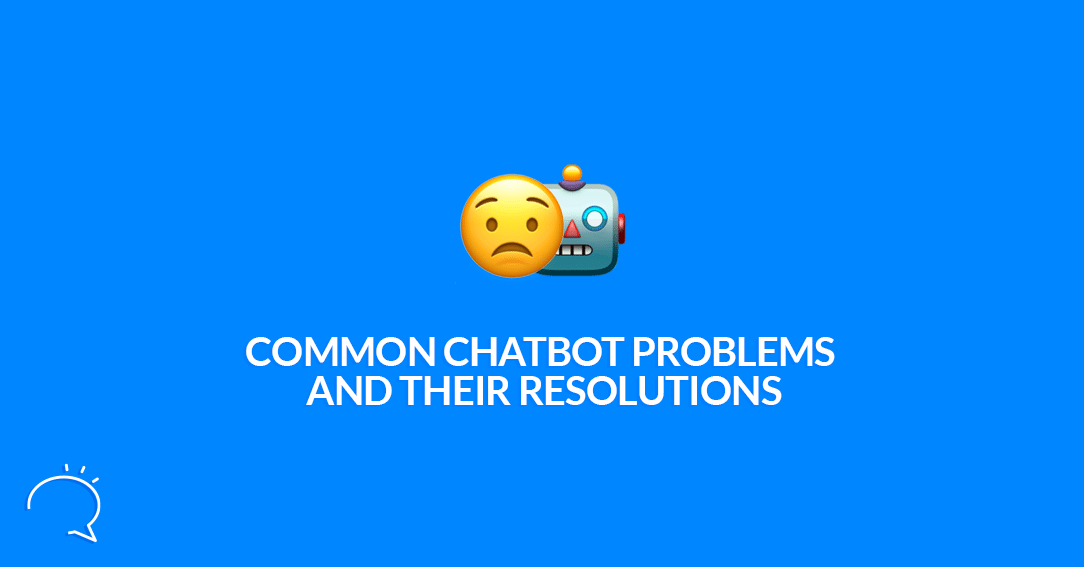99 chatbot problems, but this ain’t one! Chatbots are amongst the most potent marketing and support tools nowadays. And with everyone pretty much glued to their screen 24/7, it’s kinda hard to ignore that the place to be right now with your business is inside messaging apps. More specifically Facebook Messenger, because people spend way more time here than they do on the social network counterpart; Facebook. Really, as a business, you need to take advantage of this, and we got a bunch of articles on this blog that will help you decide this is the right thing to do. However, with chatbots being so “young” compared to other marketing and support technology, it doesn’t mean this tech – with so much potential – doesn’t have its own set of problems.
So, in this article, we will get to know these possible chatbot issues and how to resolve them. Some of these problems include the flow of the conversation and the language of the user. Plus, we’re taking a look at NLP limitations as well as some other chatbot problems. So, Let’s take a look at each of these chatbot problems together, and let’s find out how you can resolve them. Making sure your chatbot keeps delivering the best support in pre/post-sales.
Common Chatbot Problems & How to Solve ‘Em!

Chatbot Problems & Their Resolutions
In this section of the article, we’re going to check out some common chatbot problems and issues, together with their resolutions. Ready? Read on!
1. Message Interpretation
We’re kicking off with Message Interpretation. Chatbots that offer customer support encounter one of the most significant challenges; interpreting the messages from customers. It also involves being able to understand user intent. Flexible algorithms for message intent’s interpretation should be in there.
Plus, there is just an absolute plethora of writing from the customers. See, some customers write in short sentences, short bursts of words. While others prefer long-form essay-like messages. And, of course, you have those people who write in colloquial language. Regardless of how a customer types in chat… The chatbot needs to understand this. They should not always respond with a, “Sorry, I cannot understand it, can I connect you to a human?”… Because it defeats the purpose of having a chatbot in the first place.
So, yea, this is the first of chatbot problems one can encounter, and there are actually various solutions. It can be as simple to ask the customer if they would be willing to express themselves in general terms. Or, what kind of format the chatbot needs. For instance, if we take a look at the Support Flow in the Clepher chatbot… Once someone wants to create a ticker throughout the bot, they first need to leave their email address with us, then we specifically ask them to write the problem in 1 singular message, not multiple lines. With these 2 data points, we’re able to create a ticket in the support platform we use. This way, we’re able to follow up on both Messenger, our support desk, and we keep a record.
But, there are other ways as well. If you like advanced stuff, you can think of building, or using an existing, algorithm. Some of our customers use Dialogue Flow and integrated this in their chatbot to offer a more versatile way of answering questions. An easier way is just thinking about all sorts of questions a customer can ask, and in the way how they can be asked, derive keywords from that and add those keywords as triggers to the messages.
2. Chatbot Security
Secondly, we have Security. Security problems and issues are perhaps most common in the world of technology. And frankly, these problems are not sparing chatbots. Chatbots must be secure from square one. And that starts by choosing a platform that you’re confident enough to build on, like Clepher *wink-wink*. We actually take this to heart. More so, we hate it to find out that a competitor left their backdoor open again, and leaking tons of customer data.
True story, by the way, but luckily that chatbot platform doesn’t exist anymore… The owner shot a demo video and for some reason, the password was not being masked. Stupid, I know! And with the account being an admin account, you could access the entire database of customers. What could they’ve done to resolve this? For starters, program properly, and of course adding two-factor authentication and end-to-end encryption.
That said, though, people talking with a chatbot should know the bot can use their personal data to personalize their experience. Being upfront about this is actually a good thing. We see that user confidence gets a boost, plus, while mentioned at the start of a chatbot conversation, it increases their sense of security. As a result, they’re more likely to stick around longer and chat with the bot.
3. Natural Language Processing Limitations
Then we have NLP, does it have limitations? Well, I hate to bring it to you, but the current conditions of NLP are not yet advanced enough to conquer everything. And yea, it’s hard to keep up with language complexities, but many chatbot specialists agree it takes time before NLP becomes truly useable in chatbots. But, since it is a process, it means it will evolve more towards a solution. To speed up its evolution and to provide the right resolution, it is crucial to answering the following questions. How much time will it take NLP to transform to the average human level? How well will you and your chatbot be capable of leveraging it? And what can you do at the time it journeys to being a smart chatbot?
4. The Possibility Of Confusing Your Users
Your chatbot’s Return on Investment (ROI) may range from 200% to as high as 20,000%. It really depends on what your chatbot is going to do… But you won’t get anywhere near there those whopping percentual increases if your chatbot is not following the best practices. Like, if a chatbot is not planned out well, it might confuse users. Plus, chatbots that are not tackling certain best practices, like, whether you should inform users that the bot is a chatbot and not a real person… are bound to deliver a poor experience. The solution here is simple. Follow best practices, and set expectations at the start of a conversation.
5. Failure To Address The Customer’s Limited Attention Span
The attention span of most people is often limited. According to a report in The Guardian, the average attention span of the human being is narrowing. Typical estimates say the attention span of teenagers and adults ranges from 10 to 20 minutes. But, there are even studies indicating attention span is even less, at 12 seconds and 8 seconds. Knowing that people are easily distracted, it’s the chatbot’s task to understand this… And make sure to ‘wow’ them at the steps where people are most likely to drop off. This is where conversational UI comes into action. The aim is to hook people in, and the easiest way to do this is with attention-grabbing messages. And then, when you succeed, the chances that people talk with your chatbot again, are very high.
6. Chatbots That Don’t Follow Best Practices
We already touched upon this under point 4, chatbots that don’t follow best practices… So, are there such chatbots? Well, there are. It’s best to avoid building a chatbot that ignores following best practices. That’s why, at the start of the process, it’s a good thing to determine the language you want to use in your chatbot, the tone, and the flow of conversation. A good way to start is familiarizing yourself with the conversation design basics. Just follow the link shared earlier in this paragraph to get a quick refresher.
7. Chatbots Must Coincide With Your Brand Identity
Chatbots have to be carefully created. It must coincide with your brand identity. One of the most incredible marketing tools is your brand identity. Regardless of whether you are a business or an organization in the public sector. Your brand identity is how your customers and consumer recognize you. And that’s why the chatbot should complement the brand. You can find several companies that succeeded in doing this. For instance, Disney is thematic with their chatbot (we wouldn’t expect anything less). Disney’s chatbot actually shows it’s all from the form of the writing of the messages to the chatbot concept, all the way to how the conversation flows.
Some chatbots that are created by businesses are not consistent with the brand. How to resolve this problem? Well, looking for a chatbot specialist who can work with you is one. There are chatbot specialists today that can help you create chatbots in a flash while taking into account your brand identity. By having a chatbot specialist work with your team, they will match your chatbot with the brand identity with ease. If your brand is light-hearted, the chatbot should be friendly and conversational… If your website is for the corporate setting, using professional language is essential.
Introducing Clepher’s Drag ‘N Drop Chatbots
When it comes to the best platform that can solve all these chatbot problems and more, choose Clepher. Chatbots built on Clepher are taking off, and they are taking charge of enhancing the customer support and sales cycles of businesses. And, with Clepher, you get a drag-and-drop feature. This lets you create your chatbot without the need for coding. Yup, this means there are no tech headaches, allowing you to make the chatbot of your dreams. The platform has the Flow Composer to guide you further through.
With Clepher, you have your one-stop platform for creating chatbots, plus your very own marketing suite. You also have powerful automation rules and super fast broadcasts. And there are also live chats, growth tools, and more. Why not dip your toes in the water while it’s nice and warm? Get Started with Clepher today.
Related Posts



